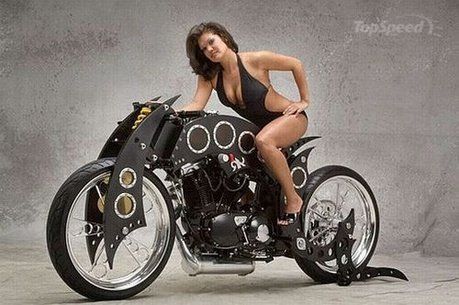 The Norton twin has a mixed history in the eyes of collectors, and has never achieved the level of desirability of even the humble sidevalve models from the 20's. First laid out in 1947 as a response to the huge success of Edward Turner's lovely Triumph Speed Twin (fully 10 years after that sensational debut), the new Model 7 'Dominator' of 1948 was designed by a protege of Turner's, Bert Hopwood, which did nothing to dispel the image of a 'copycat' machine.
The Norton twin has a mixed history in the eyes of collectors, and has never achieved the level of desirability of even the humble sidevalve models from the 20's. First laid out in 1947 as a response to the huge success of Edward Turner's lovely Triumph Speed Twin (fully 10 years after that sensational debut), the new Model 7 'Dominator' of 1948 was designed by a protege of Turner's, Bert Hopwood, which did nothing to dispel the image of a 'copycat' machine. The Model 7 engine was installed in the cycle parts of the ES2 single, with Roadholder forks and 'Garden Gate' (so-called due to its tendency to feel 'hinged' while racing - so much for Norton roadholding!) plunger frame.

The reputation of Norton was at the time completely built on their immortal 79x100mm singles; 16H, Model 18, International, and Manx. While a few vertical twins had managed successes in competition by 1948 (see post on the Wicksteed blown Triumph), it was obvious to any motorcyclist interested in competition that this new design was really not a Thoroughbred, and contrary to the claim of the Triumph 'GP', this design had no Grand Prix future at all.

Nortons seemed almost embarrassed at the introduction of the Model 7, which is understandable given their corporate culture and history. Norton had spent the previous 20 years trouncing their competition in International racing with their well-developed singles. They must have eaten a bit of Humble Pie to be forced to create a twin-cylinder machine to compete with Triumph in sales, but thus was the economic reality of postwar Britain. The demand for big Singles was on the wane, and every major factory in Britain began to produce twin-cylinder machines (even Velocette - but theirs was the 'LE'). The above photo shows the new Model 7 at the Earl's Court Motorcycle Show in 1948; with Bert Hopwood himself and Joe Craig, maestro of the Race Shop, with his hand on the seat. What Joe is thinking to bring that curious smile to his face is worth conjecture; we need a Caption Contest!
Here's mine; 'This golden goose better pay for my 4 cylinder racer...'

The Model 7 engine was installed in the Manx's Featherbed frame in 1951, becoming the Model 88 Dominator. In response to American demand for More Power, the capacity was increased in 1956 to 600cc (the Model 99), and in 1961 the frame top rails were pinched together to make the Slimline frame (requiring less of a bow-leg to sit comfortably), and the 650SS model was introduced, which was truly Norton's answer to the Triumph Bonneville. The Atlas arrived in 1962, as the trump card to the Bonnie (which didn't grow to 750cc until 1973).

The Atlas was named after the Intercontinental Ballistic Missile (ICBM) developed in 1957, which formed the backbone of US Air Force nuclear deterrent strategy ('Mutually Assured Destruction' - MAD). It was soon adapted by NASA to launch satellites into orbit, then humans too, as the chief booster of the Mercury space project, which by 1962 had launched John Glenn into orbit. With a namesake of such awesome and threatening power, perhaps it was fated that the Atlas gained a mixed reputation.

What the buyer got with the Atlas: Cycle parts which were the Gold Standard of motorcycle handling from 1951 until the late 1980s - the Featherbed frame (designed by Rex and Cromie McCandless in 1949), and the Roadholder forks (designed before WW2, after the BMW tele forks). An excellent gearbox, developed from the Sturmey-Archer design from the early 1920's (Norton purchased the design in the early 1930s, and continued to develop the 'box until the final Commando in 1978). Electrics which were at least modern (ie, an alternator), if not quite in Japanese e-start territory (that came in 1975 on the MkIII Commando). The tinware was attractive, if not as pretty as a Triumph, with deeply valanced chrome mudguards and a big chrome Norton flash badge. Weight was 435lbs or so with a bit of fuel. The clutch wasn't really up to the job of handling the massive torque of the new low-compression engine (7.6:1), and tended to slip when the throttle was suddenly opened. As for the engine itself, it developed 50hp @ 6800rpm, not that you would want to stay at such revs for long; luckily, the Atlas developed power all over the place, from almost no revs, and didn't need to have its neck wrung to build up speed.

Which certainly echoes my own experience. An Atlas was my first British motorcycle, when as a young lad I was a budding Rocker. In 1985; I read an ad in Citybike magazine for a 'low-mileage, fully rebuilt' '65 Norton Atlas 750cc ($800!), so I hitched a ride from SF to Santa Cruz to pick it up. I was a complete newbie to Britbikes, and didn't think much of the fact that the gas tank had been trimmed at the bottom (where it wraps over the frame tubes), the front fender was missing, and worst of all, the headstock had been altered to give more 'rake' to the forks.
It ran fine, and I rode it back to San Francisco over Skyline Blvd, testing the limits of the new machine, soon discovering that the bike shook so badly over 90mph that I literally couldn't see straight - everything became a blur. I had read all the literature I could find about this model, and had been warned, but it was still surprising to experience such vibration, especially as my previous bikes had been smooth vintage BMWs and Hondas. I kept that first Atlas for about 3 years, making some improvements, but the fact remained that I had bought a dog. After rebuilding the engine completely after only 3000 miles, I sold it along, vowing never to own another one.

My second Atlas (!) was a racer in a nickel-plated Wideline frame, Manx fiberglass tank, and huge Fontana magnesium brake. The engine had been beautifully worked over, with larger carbs (magnesium bodied Amal Concentrics - and I bet you've never seen a pair!), big valves, high-compression pistons, a genuine gold Lucas Racing magneto, Manx alloy oil tank, alloy rims, and a home-made rear disc brake setup. Shockingly enough, it was fully epuipped for the road, 'ish', as the 2-into-1 exhaust with reverse cone megaphone was devoid of silencing. The engine was much smoother than that first Atlas, and had been clearly built up by an expert. It was understandably a bit of a monster on the road, although the power was amazing, and it was certainly the fastest vertical twin I've ever owned.

My third Atlas hardly counts, as it was a basket case, and was resold before I had turned a wrench, to a fellow who wanted to build a Triton. Such was the fate of many an Atlas, I fear; the temptation to ditch the Hopwood vertical twin in favor of the Edward Turner Triumph was too great. And you must admit, Turner had a flair for proportion and detail which eluded Hopwood - the Norton engine is attractive, but workmanlike and not especially beautiful (sacrilege!). While the performance gain from adding a Triumph twin engine of 650cc capacity is nil, the Triton lives on today as a means of improving the handling of the Triumph powerplant.

Last year I bought my current 1966 model, in silver, for two reasons: 1. Whenever my path crosses with local collector Mike Shiro, always seen riding a 60's British twin (Triumph, Norton, Matchless), he looks so damn cool. 2. The Atlas was a known quantity, bog standard, in lovely condition, and didn't smoke or rattle. The Atlas is an underappreciated model here in the US, with a deserved reputation for bad vibration; thus they can be found very reasonably.

As per its reputation, the Norton 'Featherbed' frame is solid as a rock, with a bit of rake to the forks, requiring modest effort around bends. You don't 'think' this machine through corners, you nudge it, and it will do whatever you ask. It's possible to change 'line' in the midst of a corner, even a fast one, and while it always feels safe, it isn't necessarily agile.

Last summer I spent a week riding this Atlas through some of the twistiest roads CA has to offer - I mean 5 hours continuous riding through 30-50mph corners. At some points, with a passenger on board, I could feel myself really pushing the handlebars when changing direction quickly; this never got tiring, but it was noticeably different for me, having become used to smaller machines. I'm sure many riders, used to modern machines, would prefer the stability of the Norton, as it feels safe as a house.
As the 750cc vertical twin is decried for its vibration, I was a bit worried about riding it for a week, wondering if my hands would swell and my fillings fall out. But I came to understand the bike, and found its sweet spots, so that by Friday I could report an extremely smooth and very comfortable ride. The character of the machine changes dramatically when the throttle is twisted past Medium. When power is needed, say for overtaking cars, the Atlas surges forward like the rocket for which it's named, without any fuss or drama, but certainly with vibes.
But, if the throttle is used judiciously, the Atlas is actually an exceptional Sports-Tourer, requiring few gear changes even in rapidly changing conditions. I found it almost never necessary to use first or second gear, except when starting from a dead stop. Even in 20mph hairpins, third gear would suffice, and a gentle twist of the throttle would see the bike surging forward out of the bend. With a passenger, the Atlas has power enough to handle just about any hill or bend with disdain; such is its Manx heritage, and the breeding shows. I suppose I've made peace with the model after all these years.









No comments:
Post a Comment